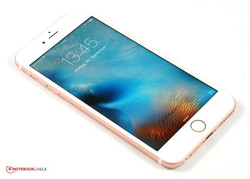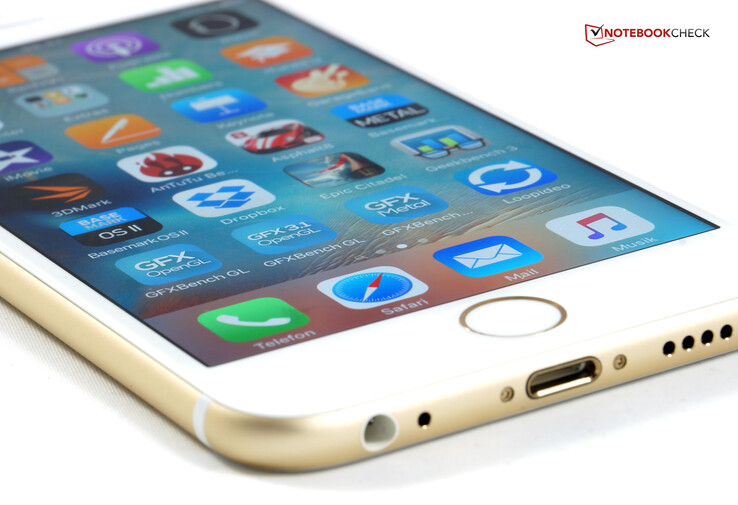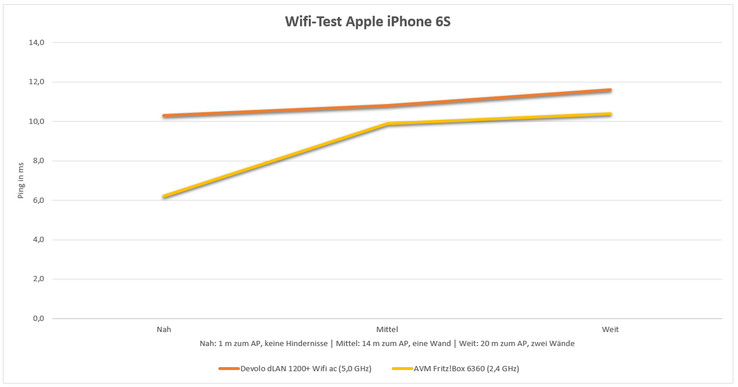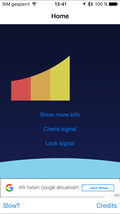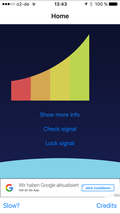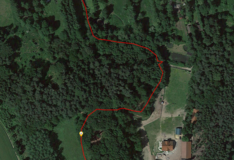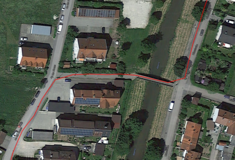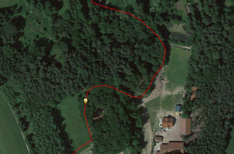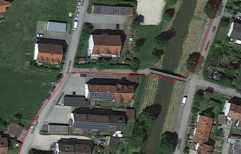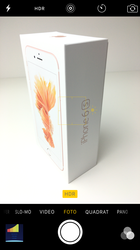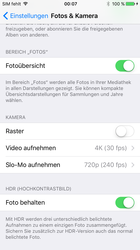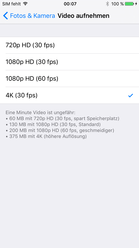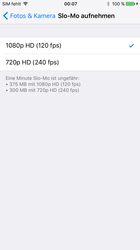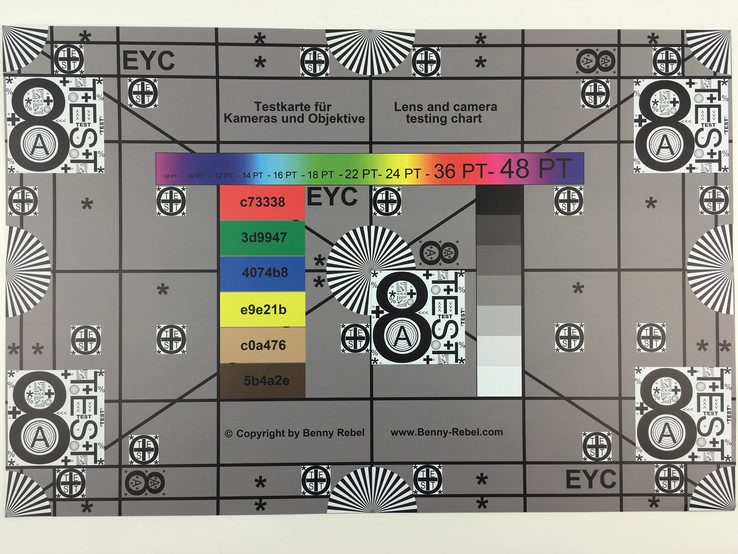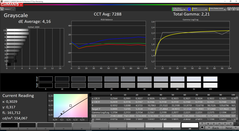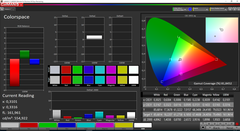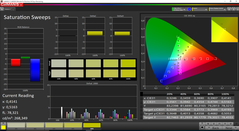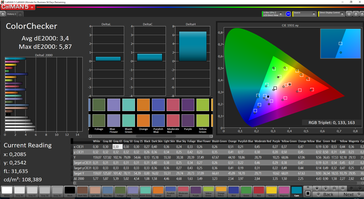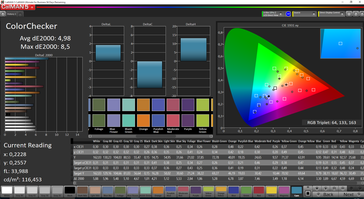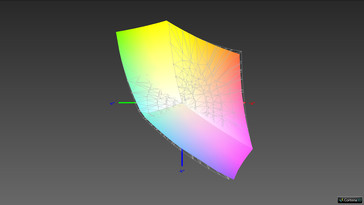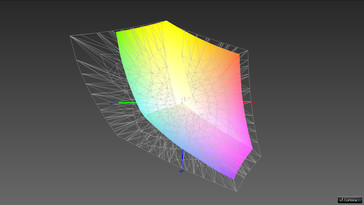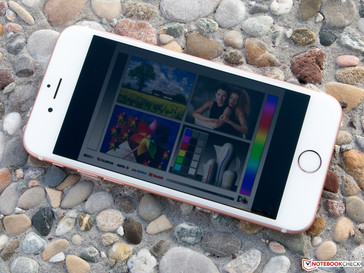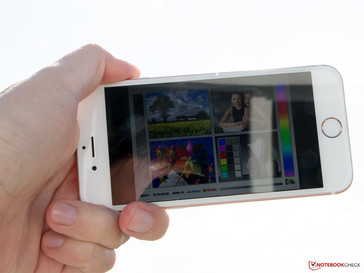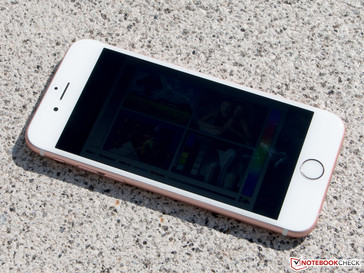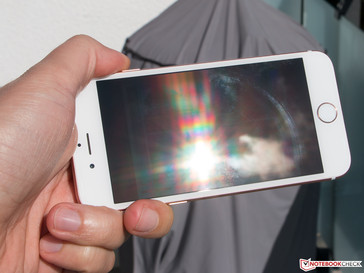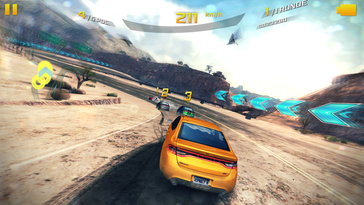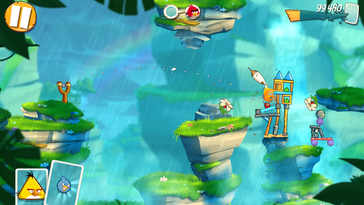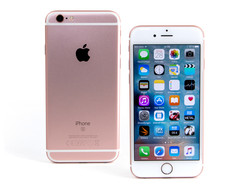Apple iPhone 6S Smartphone Review
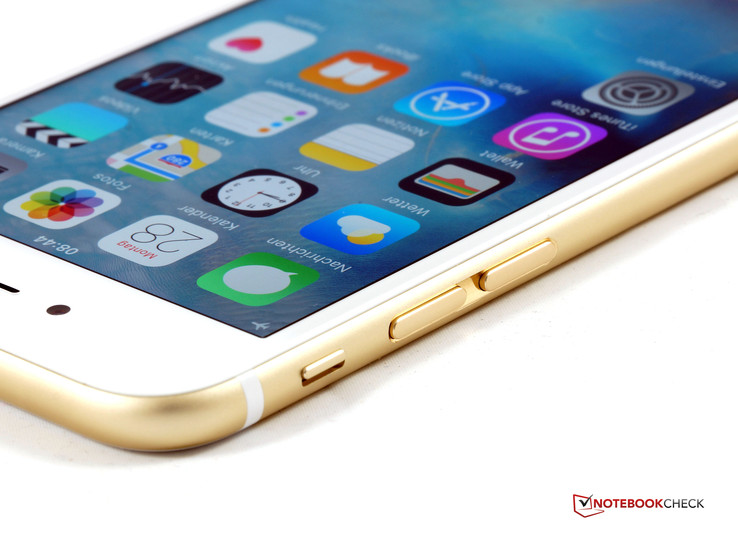
For the original German review, see here.
If Apple launches an iPhone with the suffix "S", then it is usually a restrained facelift, whose additional value is defined by the higher performance. This is basically also true for the new Apple iPhone 6S, but the Americans also use the current S models to introduce a new control concept. Thanks to 3D Touch, the iPhone can be controlled not only via taps and swipes, but also via pressure on the touchscreen.
The Americans also updated the internals. The iPhone 6S is equipped with the new A9 chip, which is supposed to be up to 90 percent faster, new and faster communication modules, better cameras and a smaller battery. Does smaller also mean lower capacity? Exactly. But according to Apple, the battery runtimes will not suffer. In addition, if it does run a bit low on power on the way home, you can use the new energy-saving mode.
Apple also adjusted the prices, but not for the better. The iPhones of the 6S generation are now between 40 and 60 Euros (~$45 and $67) more expensive than the predecessor. The prices start at 739 Euros (~$828) for the 16 GB model, 849 Euros (~$952) for our 64 GB review model and all the way up to 959 Euros (~$1075) for the top model with 128 GB. The storage still cannot be expanded, so the 16 GB version is pretty much out of the race if you want to use the smartphone appropriately.
Apple also introduces a new color version for the new smartphone generation: Rose Gold is the latest addition to the familiar colors Space Gray, Silver and Gold.
Case
That the design of the Apple iPhone 6S would not differ from the predecessor was clear long ahead of the presentation, because that is typical for Apple's S models. Still, the current iPhones got more chassis changes than any S version before. The iPhone 6S is slightly bigger in every dimension, and the weight was increased as well. The reason for that is the new control concept 3D Touch with its sensors that result in a heavier display. Another factor is the new Taptic Engine, a new kind of vibration generator. However, the additional 14 grams (~0.5 oz) for the small iPhone are not as noticeable as the 20 grams (~0.7 oz) for the bigger sibling. At 143 grams (~5.0 oz/0.3 lb), the 4.7-inch 6S is one of the heavier models in this size class, but the weight is not tiresome yet. The iPhone 6S is now 7.1 millimeters (~0.28 in) thick, and the main camera is still protruding from the back.
Despite the similar design, the new iPhones have a completely new chassis. The metal unibody of the 6S is made of 7000 series aluminum, which is characterized by a very high strength of 220 up to 700 NM/mm². The new alloy is probably supposed to prevent another Bendgate. We also hope that the current iPhones are less prone to micro scratches compared to the predecessors. The same applies for the new Ion-X glass at the front, which is the most robust in the whole segment according to Apple.
Connectivity
The technical basis of the Apple iPhone 6S is identical to its bigger sibling with the additional "Plus" in the name. At the heart of the new models is the Apple A9 chip, which has a CPU that is supposed to be 70 percent faster and a GPU that is supposed to be 90 percent faster than the A8. This would be a huge improvement and the iPhone 6S would certainly be one of the most powerful smartphones right now. The preview already showed that this assumption is not too far-fetched. Apple doubled the amount of memory to two GB. This might not sound very generous compared to the best Android phones, which are sometimes already equipped with 4 GB. But Apple develops both the hardware and software, so 2 GB might actually be sufficient. In the past iOS devices always belonged to the fastest devices when they were launched.
The internal storage capacity is still 16, 64 or 128 GB. If you want to use your smartphone for pictures or video recording – the 6S now also supports 4K videos – you should not even consider the 16 GB version, which is why we see the 64 GB version as the entry-level version. We are already used to the fact that you cannot expand the storage of Apple smartphones.
This is also the case for the proprietary Lightning port, which still only supports USB 2.0, but you get numerous adaptors for it to attach an external display, for example. USB Type-C is not available on an iOS device so far.
Software
The current iPhones are the first that are shipped with iOS 9 ex-works, which is the latest release of the mobile operating system from Apple. iOS 9 has been available for a couple of days now and obviously runs on older generations as well, just like the recently tested iPad Mini 4. A large number of the functions, however, are reserved for the 6S generation. The big highlight is obviously 3D Touch, but we will have a closer look at it in the section "Input Devices & Handling". Also new and only for Apple’s smartphones is the energy-saving mode, which is obviously supposed to enable longer battery runtimes. The energy-saving mode can be activated manually – via switch or Siri voice command – in the settings under the new menu item "Battery". If the battery capacity drops to 20 percent, the system automatically asks if it should activate the feature. As a result, some background processes like push mails via IMAP4 are deactivated, the brightness is slightly dimmed and the CPU performance is throttled. Still, the remaining capacity is easily sufficient for common tasks. It is still not possible to activate the energy-saving mode all the time. The system automatically deactivates it as soon as you charge the smartphone and the battery capacity reaches 80 percent.
A big topic of iOS 9 is multitasking…, but not for the iPhones. The latest features called Slide Over, Split View and picture-in-picture are only available for Apple's iPads. The performance can certainly not be the reason. One reason in the case of the iPhone 6S could be the limited display size, but the bigger sibling offers much more space and does not get multitasking, either.
Apple noticeably improved the fingerprint scanner that is integrated into the Home button. Touch ID 2 now works almost without delays and –even more important – also works much more reliably, especially with wet fingers.
Apple’s personal assistant Siri also got a small update and can now listen all the time if you want. It is possible to activate Siri directly with the command "Hey Siri!" so it can get the corresponding voice commands, even when the iPhone 6S is in standby. Voice commands make much more sense like this. At first, Siri has to learn the voice of the user, so the wrong smartphone is not accidentally activated or multiple devices react to one voice command at the same time. We also tried it, and the voice differentiation worked very well during our test. Not many apps can be executed when the display is locked, but calls are possible, for example. Even the entry of a phone number worked without problems. This means you always have your hands free and can keep your eyes on the road when you are in the car. Siri can also inform you about appointments. It is unfortunately not possible to start the navigation from standby, because the device has to be unlocked first. It is still a nice feature that Siri can now be active permanently.
Communication & GPS
The Apple iPhone 6S communication modules leave a good impression. Mobile Internet connections can be established via HSPA+ (up to 42 Mbps downstream) or fast LTE Cat. 6 (up to 300 Mbps). The latter supports 23 LTE frequencies and is therefore not only suited for Europe, but should be fine almost all over the world. Only the 1,500 MHz band is missing, but this is not a huge problem since it is not in use yet.
The Wi-Fi module supports the IEEE 802.11 standards a/b/g/n/ac in 2.4 and 5 GHz networks. The new smartphones also use the fast MIMO Wi-Fi standard now, for transfer rates of up to 866 Mbps.
The iPhone 6S hardly differs from the larger sibling 6S Plus in terms of Wi-Fi signal quality. Quite the contrary, the ping times are even a bit lower in the 2.4 GHz network on average. It is the opposite in the 5 GHz range. However, this will not make a noticeable difference in practice, because the Wi-Fi range of the iPhone 6S is also very good even at a long distance to the router and there are no problems when you stream an HD video. We should mention that this is only possible in 720p on the iPhone.
NFC is available on the iPhone 6S, but can only be used in combination with Apple Pay. This is unfortunately still limited to the United Stated and Great Britain.
Bluetooth 4.2 is also available and up to date. The connection was very stable during audio streaming and there were no dropouts during a couple of hours. The range is decent as well at up to 10 meters (~33 feet) if there are no obstacles. If you need even more range, you should have a closer look at the Huawei P8: Its range was more than 50 percent higher, even though there were walls in between.
The iPhone 6S uses the satellite networks GPS and GLONASS to locate the position. The satellite fix was also very quick indoors and established within a couple of seconds. It was even quicker outdoors.
We compare the accuracy of the location with the bicycle computer Garmin Edge 500. Similar to the iPhone 6S Plus, the smaller version also performs very well and is on par with the professional navigation device. Sometimes the smartphone is better; sometimes the Edge is a bit more precise.
Telephone & Voice Quality
Apple did not change the phone app. We would have actually expected a bit more in terms of calling when you consider the price level of the iPhone 6S. The voice quality is still good when you hold the device to your ear, as long as the environment is not too loud. Our voice, however, could be a bit more natural on the other side. It gets a bit tricky in louder environments, because the noise suppression cannot filter all the noises.
Making calls via the speaker of the smartphone is only possible in a quiet environment. Even then, the voice of the Apple user sounds pretty tinny, but loud ambient noises will swallow the voice completely. All in all, the Californians should improve the voice quality a bit to meet the premium expectations.
Cameras
The cameras of the iPhone 6S are almost identical to its bigger sibling 6S Plus, the small model only lacks the optical image stabilizer. The old 1.2 MP camera at the front of the predecessor was finally replaced by a more modern 5 MP unit (1932x2576 pixels). It has, among others, an automatic HDR mode and can record Full HD videos. The pictures are comparatively good. You can only notice that details are not really sharp and edges are a bit blurry when you zoom in. The display can be used as a flash, which does not really help all that much in low-light situations, but it does at least reduce the shadows in the face a bit. There is no special Beauty mode.
The main camera now has a 12 MP sensor (4032x3024 pixels), which corresponds to an increase of 50 percent. This is still not extremely high, but the resolution is not all that counts. Apple also claims to have improved the technology. It was unfortunately not enough to reduce the height, because the camera still protrudes from the back by 0.8 millimeters (~0.03 in).
The camera modules are very similar and the software is identical as well, so the pictures are almost identical to the iPhone 6S Plus. The detailed analysis of these shots is available in this review. It is, however, interesting that the iPhone 6S, which only has an electronic image stabilizer, takes a better picture in the low-light scenario (scene 3) compared to the bigger sibling with OIS. The picture is very sharp and shows how well Apple’s improved noise reduction works.
But the results of the iPhone 6S are also very good in daylight. The sharpness is good, but you can see that the camera is actually a bit worse compared to its predecessor in this respect when you zoom in. The dynamic range could be a bit bigger as well. Still, the performance of the review unit is very good.
According to Apple, Live Photos are the big camera highlight of the new iPhones. However, this feature is not as new as Apple wants us to believe. Something similar is already available in the flagship models from Microsoft’s Lumia series. Apple just expands it a bit and sets a moving element before and after the actual picture. Similar to the Lumias, it is only possible to watch the Live Photos on the smartphone, but the single picture is saved as well.
There is finally Ultra HD video (3840x2160 pixels, 30 fps, around 49.8 Mbps). It is also possible to record Full HD videos at 30 or 60 frames per second. Time-lapses are possible, just like slow motion. The latter can either be recorded at 120 (1080p) or 240 (720p) fps. The picture quality is comparatively good, and we preferred the videos in 1080p at 60 fps. The picture is smooth, as expected, and it also stays sharp when you turn the camera quickly. The sound is at least recorded in stereo, but the quality is just average.
The camera software unfortunately only has limited settings or they are complicated to access via system settings. A manual mode is not available, so Apple still has room for improvements.
Color Accuracy & Sharpness
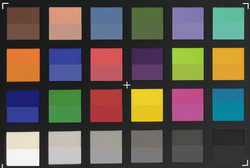
We took a picture of the ColorChecker Passport under controlled lighting conditions to analyze the color accuracy and compared it with other current smartphones. We used the automatic mode of the smartphones and compared and analyzed the pictures without any editing (no white balance afterwards). Both the iPhone 6S and 6S Plus can take the lead with the Sony Xperia Z3+ in terms of color accuracy. They are closely followed by the OnePlus 2 and then the Elephone P8000. Honor 6+ and 7 and particularly the HTC One M9 delivered the worst results. Their color deviations were significant for all colors.
The new iPhones also leave a good impression in regard to the automatic exposure and they are on par with the Xperia Z3+ and surprisingly also the Elephone P8000. The worst devices in our test were the HTC One M9 and Honor 7, which were almost a whole f-stop wrong.
The sensor (or the software, respectively) of the iPhone 6S can also convince in terms of color noise (pixel noise). The noise level is surprisingly low at 0.5 percent compared to the rivals. Negative examples are the high MP sensors in the Sony Xperia Z3+ and the Honor 7.
ColorChecker |
iPhone 6s | iPhone 6s Plus | OnePlus 2 | Xperia Z3+ | One M9 | Honor 6+ | Honor 7 | Mate S | Elephone P8000 |
|---|---|---|---|---|---|---|---|---|---|
DeltaE 2000 |
5 | 5.4 | 6.1 | 5.1 | 14 | 9.4 | 8.9 | 8.6 | 7.6 |
Exposure Error (f-stops) |
-0.15 | -0,03 | 0.3 | -0.06 | -0.91 | 0.38 | 0.92 | 0.46 | -0.05 |
Pixel Noise max. (% from max. pixel level) |
0.51 | 0.61 | 0.68 | 1.51 | 0.68 | 1.28 | 1.9 | 0.6 | 1.44 |
We take a picture of the chart under defined artificial light for our sharpness test. We take a special look at the sharpness in the center, where the performance of the iPhone 6S and 6S Plus is good thanks to the higher resolution. The 20 MP sensor of the Z3Plus on the other hand shows even more details, but the OnePlus 2 and the Honor 7 do not have to hide, either. The Honor 7 and the Xperia Z3+ also produce by far the biggest files (7-8 MB vs. 2.5 MB for the iPhone, for example). Clearly beaten are the HTC M9 and Mate S. The Elephone P8000 also suffered from bad focusing.
Accessories
Smartphones are usually not shipped with many accessories, and the situation does not change when you buy an Apple iPhone 6S. You get at least a usable in-ear headset with a remote that can also control the phone functions besides the usual power adaptor, the Lightning cable and the SIM tool.
You can buy a huge number of accessories in Apple’s online store. You will find pretty much anything you can imagine: Covers, cases, bags, cables, headphones, stands and many more. Many of the products are also available for less money in other online stores.
Warranty
We already criticized the limited warranty period of just one year in the review of the Apple iPhone 6S Plus. This is obviously also the case for the iPhone 6S. If you want to extend the warranty period to two years, you have to get insurance for the iPhone. Apple offers such insurance called Apple Care+. The service for 149 Euros (~$167) also covers two self-inflicted damages for a service fee of 99 Euros (~$111) each. The classic warranty extension called Apple Protection Plan is not available for iPhones and iPads anymore.
Input Devices & Handling
Even though the design of the new iPhone generation hardly changed, the handling was heavily reworked. You obviously still operate the iPhone 6S with the fingers and appropriate gestures, but thanks to iOS 9 and 3D Touch there are many new operating methods for the smartphone from Cupertino. Besides the familiar tap and pinch inputs, you now get Peek and Pop. Those are functions that can be triggered with different pressure levels on the touchscreen. It is, for example, possible to see a preview of a link in a mail with a touch (Peek). If the content is interesting, you can just push harder (Pop) to open the website in Safari. This worked very reliably after a couple of days, especially since the pressure levels can be adjusted. Some users did, however, report that this setting does not make a difference between the individual intensities in their cases, but not everyone is affected. We did not notice a difference between the three intensities, so there is still room for optimizations. By the way, our iPhone 6S Plus showed the same behavior. This review also has more information about 3D Touch, our evaluation and possible improvements.
There is nothing to improve regarding the touchscreen and the physical buttons. Both are among the best of their kind, the screen works almost without delays and is precise up into the peripheral areas. The physical buttons are perfectly integrated and have a good pressure point. The keyboard did not really change that much. It can now display lower-case letters if you want to and – a nice feature – can be used as a trackpad if necessary.
Display
The display is similar to the old model. Apple advertises exactly the same specs for the iPhone 6S and its direct predecessor in the model comparison on its website. More precisely: IPS panel with 1334x750 pixels, a luminance of 500 cd/m² and a contrast of 1,400:1. The dual-domain pixels are supposed to ensure a very high viewing angle stability for the iPhone 6S as well. The pixel density at 326 PPI is much lower than the bigger sibling (401 PPI), but this resolution is still easily sufficient for sharp fonts and graphics.
Our measurements, for the most part, confirm the specifications from Apple. The iPhone 6S even manages a 17 percent higher luminance at up to 586 cd/m², and even the average result of 549 cd/m² across nine spots is still higher than advertised. Only the LG G4 is a bit brighter within the comparison group. We can also see a slight improvement of the review unit over its predecessor, mainly for the black value, which is now finally on a high-end level at 0.39 cd/m² and results in an excellent contrast ratio of 1,415:1. The iPhone 6 on the other hand was disappointing with just 852:1 last year. A brightness distribution of 87 percent is not perfect, but the deviations from the value in the center are still not visible to the human eye. We can already say at this point that the performance is much better than before, even though Apple obviously did not change the panel.
| |||||||||||||||||||||||||
Brightness Distribution: 87 %
Center on Battery: 552 cd/m²
Contrast: 1415:1 (Black: 0.39 cd/m²)
ΔE ColorChecker Calman: 3.4 | ∀{0.5-29.43 Ø4.79}
ΔE Greyscale Calman: 4.16 | ∀{0.09-98 Ø5}
95.93% sRGB (Argyll 1.6.3 3D)
62.18% AdobeRGB 1998 (Argyll 1.6.3 3D)
Gamma: 2.21
CCT: 7288 K
| Apple iPhone 6S A9 / PowerVR GT7600, A9, Apple AP0064K (iPhone NVMe) | Apple iPhone 6 PowerVR GX6450, A8, 128 GB eMMC Flash | Samsung Galaxy S6 Edge Mali-T760 MP8, Exynos 7420, 32 GB UFS 2.0 Flash | Huawei P8 Mali-T628 MP4, Kirin 930, 16 GB eMMC Flash | HTC One M9 Adreno 430, 810 MSM8994, 32 GB eMMC Flash | LG G4 Adreno 418, 808 MSM8992, 32 GB eMMC Flash | OnePlus 2 Adreno 430, 810 MSM8994, 64 GB eMMC Flash | |
|---|---|---|---|---|---|---|---|
| Screen | -18% | 9% | -4% | -25% | -17% | -3% | |
| Brightness middle (cd/m²) | 552 | 520 -6% | 343 -38% | 453 -18% | 474 -14% | 566 3% | 451 -18% |
| Brightness (cd/m²) | 549 | 511 -7% | 338 -38% | 439 -20% | 458 -17% | 536 -2% | 446 -19% |
| Brightness Distribution (%) | 87 | 88 1% | 94 8% | 91 5% | 85 -2% | 90 3% | 90 3% |
| Black Level * (cd/m²) | 0.39 | 0.61 -56% | 0.28 28% | 0.4 -3% | 0.47 -21% | 0.3 23% | |
| Contrast (:1) | 1415 | 852 -40% | 1618 14% | 1185 -16% | 1204 -15% | 1503 6% | |
| Colorchecker dE 2000 * | 3.4 | 3.92 -15% | 2.2 35% | 4.7 -38% | 6.32 -86% | 6.17 -81% | 3.84 -13% |
| Greyscale dE 2000 * | 4.16 | 4.33 -4% | 2.37 43% | 5.03 -21% | 6.36 -53% | 6.26 -50% | 3.97 5% |
| Gamma | 2.21 100% | 2.46 89% | 2.41 91% | 2.27 97% | 2.43 91% | 2.48 89% | 2.46 89% |
| CCT | 7288 89% | 7384 88% | 6425 101% | 7439 87% | 8218 79% | 8171 80% | 7283 89% |
| Color Space (Percent of AdobeRGB 1998) (%) | 62.18 | 87.77 41% | 72.04 16% | 58.81 -5% | 65.48 5% | 58.07 -7% | |
| Color Space (Percent of sRGB) (%) | 95.93 | 98.63 3% | 90.14 -6% |
* ... smaller is better
We can pretty much repeat our statement from the Apple iPhone 6S Plus in terms of picture quality: Black areas are only a bit pale and grayish at the highest luminance, but the blacks are rich at normal brightness settings. The colors are subjectively very good as well: Colors are vivid, but still pretty natural. Our colorimeter also confirms a very good grayscale and ColorChecker performance for the 6S, even though we can see a slight blue cast on the small iPhone as well. The color space coverage of the iPhone 6S is a bit bigger compared to the 6S Plus, but the small iPhone does not quite meet the advertised complete sRGB coverage, either. We determine almost 96 percent and 62 percent of the AdobeRGB color space.
The Apple iPhone 6S is very bright at over 500 cd/m², which is obviously a positive aspect when you use the smartphone outdoors. The visibility in the shade was always very good, even on a very bright day, and the performance is still decent with backlight. Direct sunlight or reflections on the other hand will quickly transform the new Apple smartphone into a make-up mirror. Fingerprints and dirt affect the visibility as well. Still, the outdoor capabilities of the new iPhone are comparatively good.
A real highlight of the Apple iPhone 6S is the viewing angle stability. We were already impressed by the bigger sibling, and the 6S can continue the great performance, but also benefits from the smaller display size. However, nobody will notice this difference in practice, which is also true for the slight brightness decreases and the small contrast reduction from flat viewing angles. We sum it up: Great job Apple.
Performance
Both the Apple iPhone 6S and the bigger sibling 6S Plus use the same SoC, which is sometimes much faster than the rivals. It is once again a 64-bit dual-core processor clocked at up to 1.84 GHz per core. It is supported by 2 GB LPDDR4 memory for the first time. The performance is supposed to be up to 60 percent higher compared to the predecessor.
There are not many specifications about the GPU from Apple. The manufacturer simply advertises a 90 percent higher performance. The GPUs are usually provided by Imagination, which will certainly provide its fastest component for Apple. It is very likely that the graphics unit belongs to the PowerVR-Series 7XT family. The fastest GPU from this series, the GT7600, would make sense. There are, however, no confirmations, so it is often just called Apple A9 GPU.
The benchmarks determine impressive results. Geekbench 3 shows that the iPhone 6S manages the highest per-MHz performance, which is between 70 and 130 percent faster than the rivals. The iPhone SoC only uses two cores, so the situation can sometimes change in favor of the rivals. The Galaxy S6 (Edge) and the OnePlus 2 manage better results. Still, the 3DMark Unlimited Physics Test shows the enormous performance of the A9 despite the lower number of cores, only the Exynos 7420 inside the Galaxy S6 (Edge) is faster in this case.
The iPhone can also beat the rivals in the graphics benchmarks. It manages 20 up to 150 percent higher frame rates than all the other comparison devices in GFXBench Manhattan 3.0 (offscreen, OpenGL ES 3.0). This includes the previous reference machine for gaming performance, the Nvidia Shield Tablet (Tegra K1), as even this device falls behind by 17 percent. Basemark ES 3.1 and Metal, respectively, use the most powerful APIs, and the iPhone 6S can really show its strength in these scenarios and is two to three times faster than the other smartphones.
The operating system iOS 9.0.1 ran very smoothly during the review. However, we noticed some stutters during the switch to the home screen after we used the camera extensively or played games for a while.
| Geekbench 3 | |
| 64 Bit Single-Core Score (sort by value) | |
| Apple iPhone 6S | |
| Samsung Galaxy S6 Edge | |
| LG G4 | |
| OnePlus 2 | |
| HTC One M9 | |
| Sony Xperia Z4 Tablet | |
| 64 Bit Multi-Core Score (sort by value) | |
| Apple iPhone 6S | |
| Samsung Galaxy S6 Edge | |
| LG G4 | |
| OnePlus 2 | |
| HTC One M9 | |
| Sony Xperia Z4 Tablet | |
| AnTuTu v5 - Total Score (sort by value) | |
| Apple iPhone 6S | |
| Apple iPhone 6 | |
| Samsung Galaxy S6 Edge | |
| LG G4 | |
| OnePlus 2 | |
| HTC One M9 | |
| NVIDIA Shield Tablet LTE P1761 | |
| Sony Xperia Z4 Tablet | |
| GFXBench (DX / GLBenchmark) 2.7 | |
| T-Rex Onscreen (sort by value) | |
| Apple iPhone 6S | |
| Apple iPhone 6 | |
| Samsung Galaxy S6 Edge | |
| LG G4 | |
| OnePlus 2 | |
| HTC One M9 | |
| NVIDIA Shield Tablet LTE P1761 | |
| Sony Xperia Z4 Tablet | |
| 1920x1080 T-Rex Offscreen (sort by value) | |
| Apple iPhone 6S | |
| Apple iPhone 6 | |
| Samsung Galaxy S6 Edge | |
| LG G4 | |
| OnePlus 2 | |
| HTC One M9 | |
| NVIDIA Shield Tablet LTE P1761 | |
| Sony Xperia Z4 Tablet | |
| GFXBench 3.0 | |
| on screen Manhattan Onscreen OGL (sort by value) | |
| Apple iPhone 6S | |
| Apple iPhone 6 | |
| Samsung Galaxy S6 Edge | |
| LG G4 | |
| OnePlus 2 | |
| HTC One M9 | |
| NVIDIA Shield Tablet LTE P1761 | |
| Sony Xperia Z4 Tablet | |
| 1920x1080 1080p Manhattan Offscreen (sort by value) | |
| Apple iPhone 6S | |
| Apple iPhone 6 | |
| Samsung Galaxy S6 Edge | |
| LG G4 | |
| OnePlus 2 | |
| HTC One M9 | |
| NVIDIA Shield Tablet LTE P1761 | |
| Sony Xperia Z4 Tablet | |
| 3DMark | |
| 1280x720 offscreen Ice Storm Unlimited Score (sort by value) | |
| Apple iPhone 6S | |
| Apple iPhone 6 | |
| Samsung Galaxy S6 Edge | |
| LG G4 | |
| OnePlus 2 | |
| HTC One M9 | |
| Sony Xperia Z4 Tablet | |
| 1280x720 offscreen Ice Storm Unlimited Graphics Score (sort by value) | |
| Apple iPhone 6S | |
| Apple iPhone 6 | |
| Samsung Galaxy S6 Edge | |
| LG G4 | |
| OnePlus 2 | |
| HTC One M9 | |
| Sony Xperia Z4 Tablet | |
| 1280x720 offscreen Ice Storm Unlimited Physics (sort by value) | |
| Apple iPhone 6S | |
| Apple iPhone 6 | |
| Samsung Galaxy S6 Edge | |
| LG G4 | |
| OnePlus 2 | |
| HTC One M9 | |
| Sony Xperia Z4 Tablet | |
| Basemark ES 3.1 / Metal - offscreen Overall Score (sort by value) | |
| Apple iPhone 6S | |
| OnePlus 2 | |
| HTC One M9 | |
| NVIDIA Shield Tablet LTE P1761 | |
| Sony Xperia Z4 Tablet | |
The browser performance of the Apple iPhone 6S is subjectively very good. Websites are opened almost without delays and very quickly. Web browsing is a nice experience, despite the small screen. The benchmarks confirm our impression and show that the current Safari version is once again the fastest smartphone browser. The iPhone leads the field in every comparison and does not reveal any weaknesses.
| Octane V2 - Total Score (sort by value) | |
| Apple iPhone 6S | |
| Apple iPhone 6 | |
| Samsung Galaxy S6 Edge | |
| LG G4 | |
| OnePlus 2 | |
| HTC One M9 | |
| Sony Xperia Z4 Tablet | |
| JetStream 1.1 - Total Score (sort by value) | |
| Apple iPhone 6S | |
| Samsung Galaxy S6 Edge | |
| LG G4 | |
| OnePlus 2 | |
| HTC One M9 | |
| Sunspider - 1.0 Total Score (sort by value) | |
| Apple iPhone 6S | |
| Apple iPhone 6 | |
| Samsung Galaxy S6 Edge | |
| LG G4 | |
| OnePlus 2 | |
| HTC One M9 | |
| Sony Xperia Z4 Tablet | |
| Mozilla Kraken 1.1 - Total (sort by value) | |
| Apple iPhone 6S | |
| Apple iPhone 6 | |
| Samsung Galaxy S6 Edge | |
| LG G4 | |
| OnePlus 2 | |
| HTC One M9 | |
| Sony Xperia Z4 Tablet | |
| Peacekeeper - --- (sort by value) | |
| Apple iPhone 6S | |
| Apple iPhone 6 | |
| Samsung Galaxy S6 Edge | |
| LG G4 | |
| HTC One M9 | |
| Sony Xperia Z4 Tablet | |
| WebXPRT 2015 - Overall (sort by value) | |
| Apple iPhone 6S | |
| LG G4 | |
| OnePlus 2 | |
| HTC One M9 | |
| NVIDIA Shield Tablet LTE P1761 | |
| Sony Xperia Z4 Tablet | |
* ... smaller is better
Apple uses NVMe flash storage for the new iPhones, which is supposed to be very fast and even faster than the rapid UFS 2.0 storage from the Galaxy S6 (Edge) according to our colleagues from AnandTech. We unfortunately do not have corresponding benchmarks to check this. The limited amount of cross-platform tests support this claim though. The iPhone 6S can beat the rivals in PassMark, and the results in Basemark OS II are also good, even though they are just good enough for an average position.
The iPhone 6S is once again available with three storage configurations (16, 64 and 128 GB). It is still not possible to expand the storage. Our review unit has 64 GB NVMe flash storage, and 51.7 GB can be used after the initial start. We think 16 GB are too small when you consider Ultra HD videos since the high-resolution video standard needs 375 MB per minute. The additional charge of 110 Euros (~$123) is pretty steep, so some customers will certainly get the smaller model.
| BaseMark OS II - Memory (sort by value) | |
| Apple iPhone 6S | |
| Apple iPhone 6 | |
| Samsung Galaxy S6 Edge | |
| LG G4 | |
| OnePlus 2 | |
| HTC One M9 | |
| Sony Xperia Z4 Tablet | |
| PassMark PerformanceTest Mobile V1 - Disk Tests (sort by value) | |
| Apple iPhone 6S | |
| Apple iPhone 6 | |
| Samsung Galaxy S6 Edge | |
| LG G4 | |
| OnePlus 2 | |
| HTC One M9 | |
| Sony Xperia Z4 Tablet | |
Games
The Apple iPhone 6S provides enormous performance, so you certainly do not have to worry about the hardware demands of upcoming games. All titles run completely smooth at the highest settings. The sensors work very reliably and the touchscreen executes inputs quickly, so there are no restrictions for the gaming experience.
Some games also support Apple's Metal interface, which enables some additional effects. This does look very good in Asphalt 8, for instance.
Emissions
Temperature
The Apple iPhone 6S is much cooler compared to the bigger sibling. We simulate sustained maximum load with the Relative Benchmark and can measure a moderate maximum value of 39.5 °C (103.1 °F), and just 36 °C (96.8 °F) on average, which is just lukewarm. The smaller iPhone also stays cooler than the 6S Plus while idling: The average temperature does not surpass 30 °C (86 °F), we can only measure values above 33 °C (91.4 °F) at some spots. The results of the iPhone 6S are also good in comparison with other high-end smartphones, and the power adaptor does not get too hot either, reaching up to 43 °C (109.4 °F).
(+) The maximum temperature on the upper side is 39.5 °C / 103 F, compared to the average of 35.2 °C / 95 F, ranging from 21.9 to 247 °C for the class Smartphone.
(+) The bottom heats up to a maximum of 38.4 °C / 101 F, compared to the average of 34 °C / 93 F
(+) In idle usage, the average temperature for the upper side is 29.7 °C / 85 F, compared to the device average of 32.9 °C / 91 F.
Speakers
We want to cite the review of the predecessor, because nothing changed in this section: The mono speaker of the iPhone 6 is located at the bottom and can be quite loud. The sound is fairly balanced up to around 60 percent of the maximum volume. Medium tones and bass are noticeable, though the latter could have been stronger. High tones are very clear as well. However, the quality quickly decreases with the maximum volume. The result sounds tinny and there are distortions, while the medium tones are completely gone. The sound quality of the provided headphones is quite decent, but focused on bass. The EarPods belong to the better-provided accessories on the market, but they would not be adequate for music enthusiasts.
Energy Management
Power Consumption
Smaller battery = identical runtime? That, at least, is what Apple claims. Because of the new Taptic Engine, there is less room for the battery inside the chassis of the Apple iPhone 6S compared to the predecessor. This also means the battery capacity is smaller at 6.55 Wh instead of 6.91 Wh. The measurements of the power consumption do not clearly show whether the iPhone 6S is more frugal than its predecessor. It seems so in some scenarios, but not in all. The runtime tests will give us a better idea.
| Apple iPhone 6S A9 / PowerVR GT7600, A9, Apple AP0064K (iPhone NVMe) | Apple iPhone 6 PowerVR GX6450, A8, 128 GB eMMC Flash | Samsung Galaxy S6 Edge Mali-T760 MP8, Exynos 7420, 32 GB UFS 2.0 Flash | Huawei P8 Mali-T628 MP4, Kirin 930, 16 GB eMMC Flash | LG G4 Adreno 418, 808 MSM8992, 32 GB eMMC Flash | Sony Xperia Z3+ Adreno 430, 810 MSM8994, 32 GB eMMC Flash | OnePlus 2 Adreno 430, 810 MSM8994, 64 GB eMMC Flash | |
|---|---|---|---|---|---|---|---|
| Power Consumption | 2% | -4% | -45% | -72% | -53% | -35% | |
| Idle Minimum * (Watt) | 0.5 | 0.3 40% | 0.5 -0% | 0.7 -40% | 1.1 -120% | 0.6 -20% | 0.6 -20% |
| Idle Average * (Watt) | 1.6 | 1.5 6% | 0.9 44% | 2 -25% | 1.5 6% | 2.5 -56% | 1.7 -6% |
| Idle Maximum * (Watt) | 1.9 | 2 -5% | 1.3 32% | 2.1 -11% | 1.9 -0% | 2.7 -42% | 1.8 5% |
| Load Average * (Watt) | 2.5 | 3.1 -24% | 3.8 -52% | 4.9 -96% | 6.6 -164% | 5.5 -120% | 5.7 -128% |
| Load Maximum * (Watt) | 4.8 | 5.2 -8% | 6.8 -42% | 7.4 -54% | 8.8 -83% | 6.1 -27% | 6 -25% |
* ... smaller is better
| Off / Standby | |
| Idle | |
| Load |
|
Key:
min: | |
Battery Runtime
The generation S can actually beat the iPhone 6 in every single scenario. The advantage is not huge, but it can ultimately decide whether you can play a game on the train ride home or read a newspaper instead. The minimum runtime (maximum load, maximum brightness, all communication modules, Siri and GPS active) is pretty much on par with the iPhone 6 at 2:17 hours. The maximum runtime on the other hand is almost 2.5 hours longer. The iPhone 6S manages more than 25 hours in our Wi-Fi reading test at the minimum brightness (only Wi-Fi active). Both tests are rather impractical, but they are a good indicator for the potential of the new iPhone. More interesting are the Wi-Fi and video playback tests. We adjust the display brightness to a more practical 150 cd/m² in both cases, deactivate Siri, GPS and all communication modules. Only the Wi-Fi test, which opens a new website every 30 seconds, obviously uses the Wi-Fi module. The iPhone 6S manages 8 hours – a very good result that is only beaten by the Samsung Galaxy S6 (Edge). The small iPhone also manages an excellent result of 11:30 hours during the playback of a Full HD video (H.264). Apple did not promise too much in terms of battery runtimes.
| Apple iPhone 6S A9 / PowerVR GT7600, A9, Apple AP0064K (iPhone NVMe) | Apple iPhone 6 PowerVR GX6450, A8, 128 GB eMMC Flash | OnePlus 2 Adreno 430, 810 MSM8994, 64 GB eMMC Flash | LG G4 Adreno 418, 808 MSM8992, 32 GB eMMC Flash | Samsung Galaxy S6 Edge Mali-T760 MP8, Exynos 7420, 32 GB UFS 2.0 Flash | Huawei P8 Mali-T628 MP4, Kirin 930, 16 GB eMMC Flash | Sony Xperia Z3+ Adreno 430, 810 MSM8994, 32 GB eMMC Flash | |
|---|---|---|---|---|---|---|---|
| Battery runtime | -11% | 3% | -17% | 5% | -4% | 18% | |
| Reader / Idle (h) | 25.2 | 22.8 -10% | 23.2 -8% | 27.6 10% | 22.5 -11% | 13.8 -45% | 28.2 12% |
| H.264 (h) | 11.7 | 9.9 -15% | 9.7 -17% | 8.4 -28% | 7 -40% | 9.7 -17% | 8.8 -25% |
| WiFi v1.3 (h) | 8.2 | 5.9 -28% | 5.4 -34% | 8.9 9% | 7.2 -12% | 6.5 -21% | |
| Load (h) | 2.3 | 2.1 -9% | 3.8 65% | 1.9 -17% | 3.7 61% | 3.6 57% | 4.7 104% |
| WiFi (h) | 8.8 |
Pros
Cons
Verdict
The predecessor of our current review unit did not get to the top of our Top 10 Smartphone ranking. Together with its bigger sibling, the build quality and materials are once again on a very high level as well. The iPhone 6S also convinces with good cameras, very fast communication modules and an extremely good GPS module. The display is also one of the best in the smartphone segment.
Apple’s 3D Touch is a new control concept that we really liked after a couple of days, but iOS 9 still has some bugs. We can also see advancements in term of battery runtimes, even though the battery capacity was actually reduced compared to the old model. This is possible thanks to iOS 9 and the new A9 chip.
Criticism? Pretty much always the same for Apple products: The internal storage cannot be expanded, NFC can only be used for Apple Pay, and the prices … well, you know the story.
Better is the enemy of good, which is why the Apple iPhone 6S cannot get to the top of our smartphone ranking, just like its predecessor. Nevertheless, the latest Apple smartphone is once again a great and extremely powerful piece of technology.
Apple iPhone 6S
- 04/13/2016 v5 (old)
Patrick Afschar Kaboli, Daniel Schmidt




